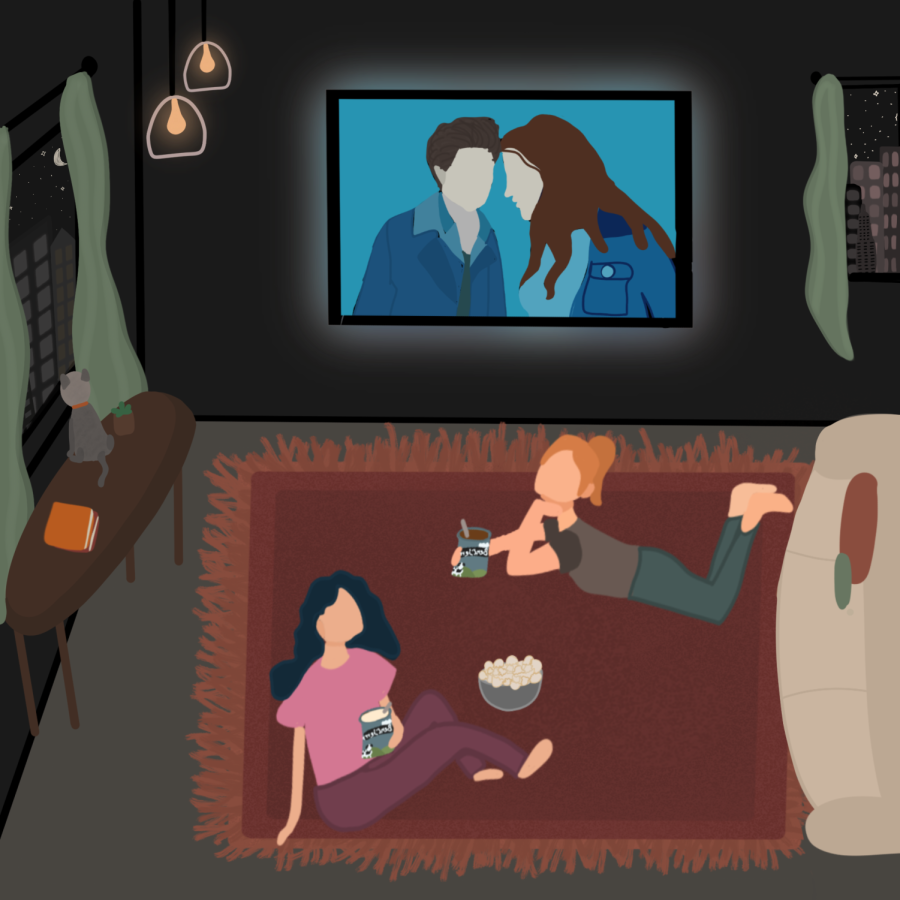You’re like a drug to me
Unpacking my emotional attachment to ‘Twilight’
February 8, 2022
When I was young, my sister, as most teenage girls did at the time, had a “Twilight”-themed party. It was complete with plates that had the character’s faces, movie posters covering the walls and a cake with a picture of, none other than, Edward Cullen. It was here that I first saw “Twilight” and began a years-long obsession that has never ceased.
When the movies first came out, I was a child and hardly the target audience. Still, despite the nine-year difference between my sister and I, we went to the theater every time a new film was released. At the time, I thought I was “sophisticated,” not only because I was watching what I thought was a “grown-up” movie, but because I was consuming media that had enveloped all of the pop culture at the time. Yet, as I grew older, that narrative began to change. As kids at school began to poke fun at “Twilight,” I began to like it less outwardly, even though inwardly I thought it was the best thing ever. This love-hate relationship was not unique to me.
Constance Grady, the culture reporter at Vox, shared in an interview with Alex Pappademas, host of the “Big Hit Show,” her bipolar sentiments towards the phenomenon.
“I was a fan, but I hated it,” Grady said. “The majority [of people] hated it because it was popular and who it was popular with. Shaming them for their bad taste rather than the content.”
Grady’s observation revealed a point that I had not pondered before — that people criticized young folks, especially young girls, for their taste in music and movies rather than criticizing the content itself.
This speaks to a larger issue. Mainstream media views things made for women, like “Twilight,” as inherently less than. The criticism between media meant to be consumed by women and media meant to be consumed by men is hardly proportionate. For instance, the “Fast & Furious” movies are made purely for entertainment but do not receive criticism to the same level as female-oriented films like “Twilight.” In the same interview, Grady spoke to the media’s narrative about the content consumed by young adults.
“We are taught the things that women like are dumb,” Grady said. “Twilight” is dumb, so ‘Twilight’ fans are dumb and if you like this thing you are less than.”
In 2009, comedian and actor Skyler Stone claimed to be holding a special screening of “New Moon,” the second movie in the “Twilight” franchise. Several fans showed up for what they thought was an exclusive event, but instead, it turned into Stone making fun of “Twilight” fans for showing up en masse for the event. Later on, Stone went on to explain he meant the joke to be a social critique of the mass hysteria the films caused among the public. Still, Stone’s ‘practical joke’ was problematic because it belittled a portion of the demographic that found “Twilight” enjoyable and thus labeled their interest as hysterical and immature. When enough of the public pokes fun at something you genuinely love, there becomes an added cultural pressure to second-guess your taste.
It wasn’t just “Twilight” that was criticized. Female-centric media like boy bands come under strict scrutiny when oftentimes they go off to become serious adult pop stars like NSYNC, which produced Justin Timberlake and Destiny’s Child, which later produced Beyonce. Essentially, the Teen Choice Awards to Grammy’s pipeline.
This time period also explains why “Twilight” was such a huge phenomenon and why it went on to be criticized so heavily.
In 1996, Bill Clinton signed the Personal Responsibility and Work Opportunity Reconciliation Act which funded abstinence-only sex education. Shortly after it permeated into the culture like the Jonas Brothers wearing purity rings. At the same time, artists like Britney Spears and Christina Aguilera were pressured to be promiscuous, but not too promiscuous, which sent mixed messages to young adults processing the abstinence-only rhetoric while consuming content that was the opposite.
Again, this time period created a double standard for women. To like Britney Spears was seen as shameful because how could you like Britney Spears and still maintain the “pure” messaging that came through mainstream media? The delegitimizing furthered the false narrative that young girls are into media that triggers lust rather than art.
It is not to say that “Twilight” is not without its faults. Several folks have criticized “Twilight” for romanticizing unhealthy relationship tactics like stalking and gaslighting. More analysis on the films emerged after the Twilight Renaissance, an internet revival of the series, emerged on TikTok. The movement was also exacerbated when Netflix put all the “Twilight” movies on Netflix in July 2021.
Discourse began when old “Twilight” fans in a post-Me Too world examined “Twilight” through a modern lens. For instance, fans on the app criticized Stephanie Meyer for writing Jasper, a vampire from the Cullen family, as a confederate soldier during the Civil War. In addition, Jacob is one of the few people of color in the movies and oftentimes the character hated the most. Not only that, Meyer falsely portrays the Quileute tribe and its legends. Since the release of “Twilight,” the movies and the books, there is no documentation of Meyer offering any form of reparation for the literary license she took over the tribe.
All of this to say, there is still a community of fans who enjoy “Twilight” and shouldn’t be criticized because of it. There will always be criticism of various movies, but to criticize the person creates a toxic environment that robs an individual of things they love the most. Part of taking “Twilight” seriously is seeing it clearly in all its complexities, but also encouraging consumers and authors to do better and learn without denying its flaws.













